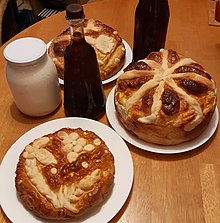Kvass
Kvass originates from northeastern Europe, where grain production was considered insufficient for beer to become a daily drink.
[21][19] Kvass has existed in the northeastern part of Europe, where grain production is thought to have been insufficient for beer to become a daily drink.
[15] In the second half of the 19th century, with military engagement, increasing industrialization, and large-scale projects, such as the construction of the Trans-Siberian Railway creating a growing need to supply large numbers of people with foodstuff for extended periods of time, kvass became commercialized; more than 150 kvass varieties, such as apple, pear, mint, lemon, chicory, raspberry, and cherry were recorded.
As commercial kvass producers began selling it in barrels on the streets, domestic kvass-making started to decline.
The development of new technologies for storage and distribution, and heavy advertising, have contributed to this surge in popularity; three new major brands have been introduced since 2004.
[27] Kvass may have appeared in Poland as early as the 10th century,[21] it quickly became a trendy beverage thanks to it easy and cheap method of production as well as its thirst-quenching and digestion-aiding qualities.
Its origins can be traced back to the 1500s, when Jan Sapieha [pl] founded the town of Kodeń on land granted by the Polish king.
Throughout the 19th century, kvass remained popular among Poles who lived in the Congress Poland of Imperial Russia and in Austrian Galicia, especially the inhabitants of rural areas.
[29] Up until the 19th century, recipes for local variants of kvass remained well-guarded secrets of families, religious orders, and monasteries.
In interwar Poland, kvass was brewed and sold in mass numbers by magnates of the Polish drinks market like the Varsovian brewery Haberbusch i Schiele or the Karpiński company.
It also gradually lost favour throughout the 20th century upon introducing mass-produced soft drinks and carbonated water into the Polish market.
[32][21][19] In the early 21st century, kvass experienced a renaissance in Poland due to the heightened interest in healthy diets, natural products, and traditions.
In 1998, the local soft drink industry adapted by selling bottled kvass and launching aggressive marketing campaigns.
[41][42] On 30 September 2010, the Saeima (parliament) adopted quality and classification requirements for kvass, defining it as "a beverage obtained by fermenting a mixture of kvass wort with a yeast of microorganism cultures to which sugar and other food sources and food additives are added or not added after the fermentation" with a maximum ABV of 1.2 percent, and differentiating it from an unfermented non-alcoholic mixture of grain product extract, water, flavourings, preservatives, and other ingredients, which is designated as a "kvass (malt) beverage".
Initially, it was made from either brewer's spent grain or wort left to ferment in a closed container, but later, special kvass bread (kaljaleib) or industrially produced malt concentrate started to be used.
It was called kalja (which can also be used to refer to small beer) or vaasa (in Eastern Finnish), while nowadays the drink is often known as kotikalja (lit.
Everything was mixed with water in a metal cauldron or a clay pot and kept warm in the oven or by the stove for at least six hours for the mixture to darken and sweeten.
The porridge or pieces of the malt bread were mixed into a wooden cask with water and fermented for one or two days with a previous batch, a sourdough starter, spontaneously or in more recent times with commercial baker's yeast.
[20] In the mid-19th century, kvass was introduced in Xinjiang, where it became known as kavas (Chinese: 格瓦斯; pinyin: géwǎsī) and eventually became one of the region's signature drinks.
[52] Following the influx of immigrants in the UK due to the 2004 enlargement of the European Union, several stores selling cuisine and beverages from Eastern Europe were established, many of which stock imported (primarily pasteurised) kvass.
As a result, since then a number of different flavours of not-pasteurised kvass, fermented using sourdough starter culture, have also become available in the UK in 2023.
[55] Naturally fermented kvass contains 5.9%±0.02 carbohydrates, of which 5.7%±0.02 are sugars (mostly fructose, glucose, and maltose), as well as 0.71±0.09, 1.28±0.12, and 18.14±0.48 mg/100 g of thiamine, riboflavin, and niacin respectively.
[56] Historically, alcohol by volume (ABV) of kvass varied depending on the ingredients, microbial flora, as well as temperature and length of fermentation,[15] but nowadays it is usually not higher than 1.5%.
It shows the history of kvass in the country as having been drunk by generations of Polish reapers as a thirst-quenching beverage used during periods of hard work during the harvest season, long before it became popular as a medicinal drink among the szlachta.
Od dawien dawna słynie napój zdrowy: kwas chlebowy, pajda chleba za pazuchę, bukłak kwasu i chłop gotów w pole.
The fermentation of sugars makes kvass slightly carbonated, thus, when shaken or heated, it can cause the liquid to suddenly and rapidly rise out of an open vessel.
[39] In Tolstoy's War and Peace, French soldiers are aware of kvass on entering Moscow, enjoying it but referring to it as "pig's lemonade".











